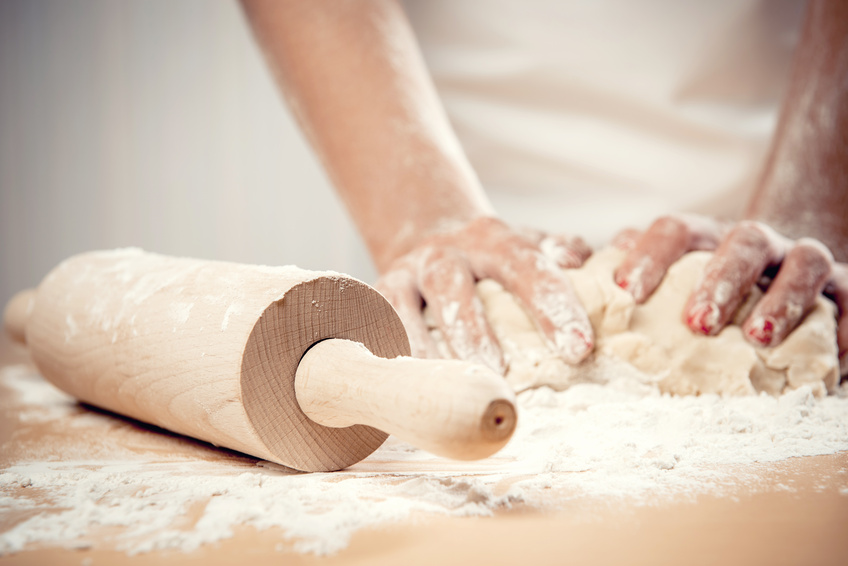
German vs American Flour Equivalents. This is something that has continued to confuse me for years now. What is the difference between flour type 505 versus 1050 and all those other numbers in between?
I understand that some flours (such as wheat and spelt) contain gluten. Gluten being the protein that forms when wheat flour and water are mixed together – the strong, sticky, stretchy stuff that is needed to give structure to whatever it is you are baking. I also know that yeast-raised flours, such as pizza dough, rely heavily on gluten for their structure. But what do the numbers mean and which one of them is REALLY the equivalent to all-purpose flour?
So I did a little research.
It turns out that in America, wheat flour is labelled according to the amount of gluten content it contains. In Germany, however, flour is labelled according to a numbering system and thus flours are sold by “Type” (Mehltyp) with a corresponding number which indicates the amount of ash (measured in milligrams) obtained from 100 grams of the flour.
So in the attempt to bring clarity to some of my confusion, I’ve compiled a list of the approximate equivalents for US and Germany’s most common types of wheat flour.
A word of caution though, European flours are not directly comparable with North American flours. There are a number of reasons for this. Firstly, it has is due with the different varieties of wheat cultivated in Europe as well the method for measuring ash and protein content. Read more here:
Different flour types and how to use them:
Type 405 / Pastry Flour
Because of its low gluten content, it is best used for baked goods that should have a soft, tender consistency yet still need some structure, such as muffins, cakes, cookies, biscuits, pie crust, and many pastries.
Type 550 / All-Purpose Flour
This is a decent choice for almost everything. It’s used mostly in home baking since it is the most versatile type of flour.
Type 812 / Bread Flour
This is the best flour for yeast-raised breads and hard rolls. Its high gluten content gives bread the structure needed to rise and hold its shape, plus it gives it a pleasant chewy texture.
Type 1050 / High Gluten Flour
It is best used mixed together with other grains and flour to provide more structure. It is also good for breads that are extra elastic such as bagels and pizza crust.
Type 1600 / White Whole Wheat
Contains whole wheat kernels, including the germ and bran, and therefore has more nutrients, fiber and fat then white flour.
Type 1700 / Whole Wheat
Good for baking a dense, hardy, nutty tasting whole wheat bread.
If anyone could shed a little light on what the German vs American flour equivalent to whole wheat pastry flour is, I would be forever grateful! 🙂
Type 00 – Italian “00” Flour
Special Italian flour for pizza. Italian “Tipo 00” is the best flour type for making homemade pizza.
What about rye and spelt?
For people with allergies and digestive issues with wheat, spelt is a good non-wheat alternative, plus it’s also suitable for some people with gluten sensitivities. Pay attention though, spelt does contain gluten, (so not suitable if you have celiac disease) but for some people who experience a mild intolerance to gluten they manage to digest it better than regular wheat. As far as baking goes, the gluten in spelt develops quickly, but since it’s fragile, you need to be extra cautious not to over-knead a spelt dough.
Rye flours are also low in gluten and come in a variety of light, medium, and dark flours. The color of the flour all depends on how much of the bran has been removed during the milling process. And because of the low gluten content, a general rule of thumb suggests substituting 1/3 of the amount of rye with a wheat flour to ensure the bread will rise properly, unless of course the result you are aiming for is a dense bread.
Roggenmehl 1150 / Rye Flour
Rye flour is darker than flours and has higher amounts of vitamins B and E. This is a medium to dark rye flour. Type 1800 is a very dark rye.
Roggen-Vollkornmehl / Pumpernickel
Coarse, whole-grain rye flour, made from the whole rye grain, including the bran and germ is called pumpernickel. This flour is given its name to a traditional German bread.
Dinkelmehl 630 / White Spelt Flour
In Germany, it is often used instead of Flour Type 405. It’s excellent for bread baking, but is usually combined with other flours because of its high gluten content. It’s a good substitute for type 405.
Dinkel-Vollkornmehl / Whole Spelt Flour
Spelt flour is one of the most popular whole grain, non-wheat flours available. It’s made from the whole spelt grain and it works well for cakes and breads.
Sources For More Information about German vs American Flour:
Fine Cooking
Weekend Bakery
Das Cupcake
A Vegetarian in Germany
Looking for baking recipes?
Check out my baking recipes archive.

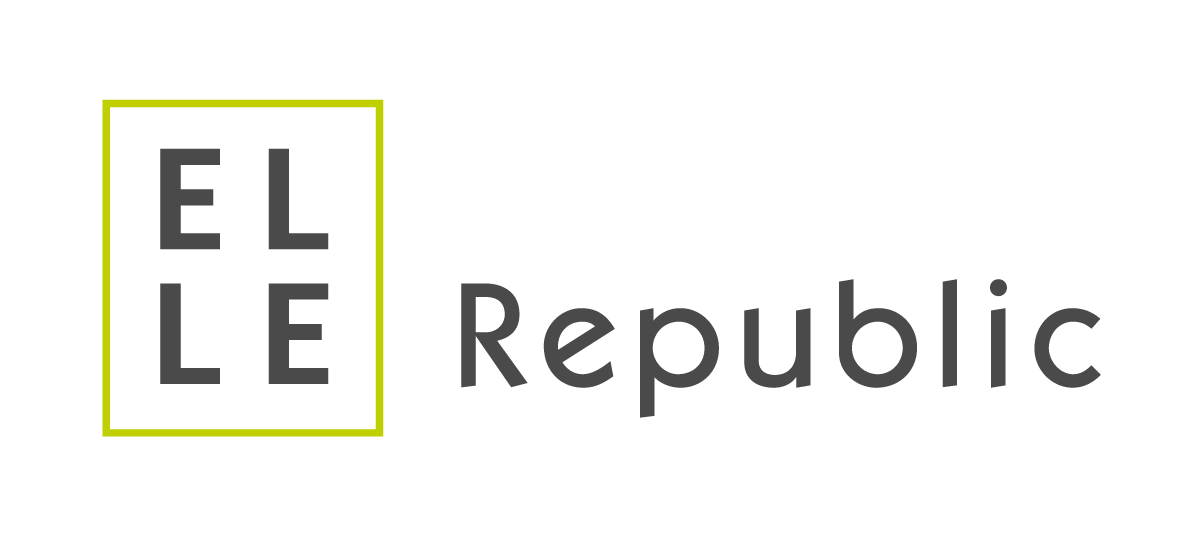

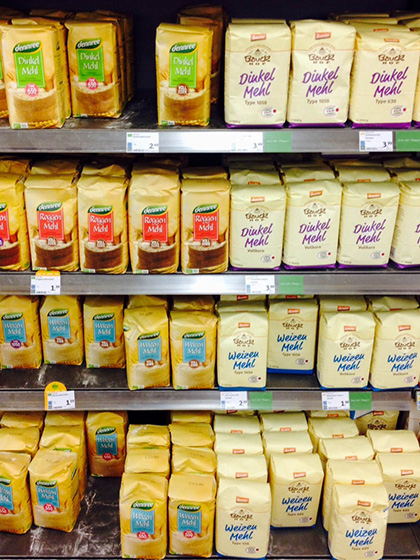
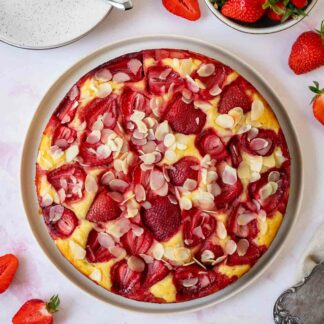
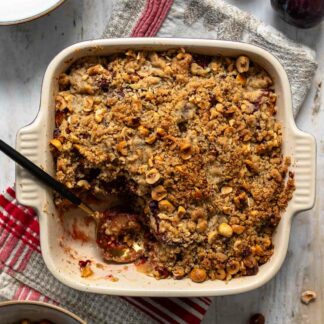
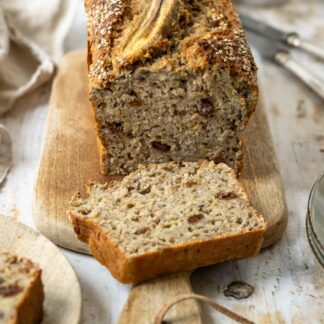

Such a wonderful explanation. I am baking real sourdough bread here in the US.
I just took any flour that was available. Sometimes even rye flour is not available.
I am feeding my sourdough with rye flour only. Then using a variety of other flours to finish it. But it seems to depend on the type of flour how well it turns out.
So now I will pay more attention to which flour is best for the sourdough bread.
Thank you for enlighten me !!
Thank you SO MUCH for doing the research and sharing it! I was about to make Beinenstich with Wheat Flour – yikes! You literally saved the cake.
You are welcome! I hope the cake turned out well. 🙂
I have a German recipe that calls for 603 flour. What is this equivalent to in the US?
Hi Inge, I am not familiar with Type 603, however there is Dinkelmehl 630 (spelt flour) which could be replaced with all-purpose flour (Weizenmehl Typ 405).
I am Bruno
And I want to Bäcker some Berliner Brötchen
but am so confused with the type of flour to use,
I can not get find the 550 german flour in any American store and I know some say to take all purpose flour, but wich one maybe someone can help me.
Hi Bruno, Type 550 is the equivalent to all-purpose flour. So standard flour should work fine. I also often trade out white spelt flour for all-purpose flour, however you need to be careful not to overmix it due to the senstive gluten structure. Good luck and happy baking!
You can also get French T55 from online stores. It’s easier to find than German equivalent Typ 550. But German 405 is able to be found online. The American AP alternatives are to go with the Pillsbury or Gold Medal, as they’re blended soft red wheat and hard red winter (HRW) wheat; they won’t have as much protein as T550, but the gluten won’t be excessive. Hard red spring wheat is usually what American bread flour uses. If you use the higher end King Arthur, you’ll get all HRW wheat which has more gluten but less protein than T550/T55.
Thank you so much, always had a hard time figuring out what flour is comparible to the #’s in Germany. BIG help, really appreciate it.
Does anyone have a one page summary of all of this ?
Do any of the flours in Germany are self rising or do you always have to add yeast to them? I can’t seem to understand that
Hi Patricia, I am not aware of any self-rising flours here in Germany, so you would need to either use yeast or another leavener such as baking powder.
There are baking mixes called Backmischung or Brotmischung (baking-/bread mix), these come with yeast, salt and often dried sour dough already added and only require water.
To my knowledge, flour usually only has a tiny amount of ascorbic acid (vitamin c) added to improve shelf life.
Thank you for sharing this baking info. It was terribly difficult trying to translate a recipe originally of countries other than the US or Canada. The different flour types makes a huge difference!!
You’re very welcome Elizabeth! 🙂
Well thank you, I was missing a translation like this since over a year. Everytime I had a recipe with “all-prupose flour” I just used Weizenmehl 405, 550 or 1050 more or less randomly. Turns out I just had to google one 😀
So glad that you find this helpful! 🙂
Since living in Bavaria for a year, I have had no luck in baking American chocolate chip cookies with whatever flour I purchased and decanted into an airtight container (so I do not know which type it is). But I will purchase 550 and see what happens. Thank you for sharing.
Hi Debra, I’ve had really great results with spelt flour and chocolate chip cookies. Maybe one of these recipes would interest you:
https://ellerepublic.de/en/chocolate-chip-cookies/
https://ellerepublic.de/en/vegan-chocolate-chip-cookies/ (this uses whole grain spelt, but could be made with 50/50)
For other baking recipes, I have also added 1 tablespoon arrowroot powder to the flour which also helps with the consistency .
Oh wow, this comparison finally exist! Thank you, I’ve been waiting for an article like this for years.
Hi Natalia, so glad to read that this is helpful for you! 🙂
Thank you for your information.
This clarifies the diferent flours.
I tried to make an all Rye bread and also a 10% Dinkel bread and each turned out to dense.
It was almost dry no mosture. I did not like it.
Now I read that both type of flour need to be mixed with other flours like Bread flour or Whole Wheat.
Thank you
THANK YOU SOOOOO MUCH for finally letting me find your site.
(I did give up long ago to figure it out though, so I haven’t really searched for it since lol)
I been living in the States 26 years now and never really got the hang of the flour types over here, besides the basics. My Dad, who was a Baker in Germany finally gave me his recipes. Unfortunately me baking bread over here always turned out to be complete disasters and almost uneatable, without really knowing which American flours to use for which German breads.
Thank you again for the thorough breakdown. Looking forward to baking once again 👍
Happy to help! 🙂 This flour thing totally confused me when I first moved to Germany, so I just had to research and write this. I think it took years before I could remember what’s what compared to Canada. BTW, I have never seen Type 812 / Bread Flour in Germany, but adding a tablespoon of arrowroot powder to a recipe seems to do the trick. Not sure if your dad the baker ever did this!
You have no idea how long I have been looking for some reliable information about this. Thank you so much for putting this together.
Thanks Sven! I was so confused when I first moved to Germany, so just had to put this together! 🙂
Is there sprouted flour available in Germany?
Hi Lisa, I haven’t ever seen it here, so as far I know, unfortunately not. Too bad!
Hello, and hope I’m not too late in my reply regarding sprouted grains. I lived in Bellevue WA for a few years and purchased my bread at ‘Spent Grain Bakery’. They got their grains from local beer breweries, and their bread was the BEST ! Check your local breweries for ‘spent grains’, and bring your own container.
This is a big help. I was totally confused with all the different types of flour,thank you
Hi Christel, so glad this could bring a little clarity for you! It’s super confusing with so many types of flour. 🙂